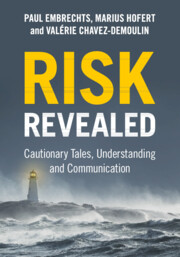Book contents
- Frontmatter
- Dedication
- Contents
- Preface
- Introduction
- 1 The 1953 Great Flood
- 2 The Space Shuttle Challenger Disaster
- 3 The 2007–2008 Financial Crisis
- 4 Earthquakes and Tsunamis
- 5 The L’Aquila Trial and the Public Communication of Risk
- 6 The Coronavirus Pandemic
- 7 Mathematical Wonderland
- 8 Stochastic Modeling
- 9 The Modeling of Extreme Events
- 10 On Climate Change and Related Risk
- 11 Further Examples from the World of Extremes
- 12 Networks
- 13 The Black Tulip and February 3, 1637
- A Note About the References
- References
- Index
9 - The Modeling of Extreme Events
Published online by Cambridge University Press: 05 April 2024
- Frontmatter
- Dedication
- Contents
- Preface
- Introduction
- 1 The 1953 Great Flood
- 2 The Space Shuttle Challenger Disaster
- 3 The 2007–2008 Financial Crisis
- 4 Earthquakes and Tsunamis
- 5 The L’Aquila Trial and the Public Communication of Risk
- 6 The Coronavirus Pandemic
- 7 Mathematical Wonderland
- 8 Stochastic Modeling
- 9 The Modeling of Extreme Events
- 10 On Climate Change and Related Risk
- 11 Further Examples from the World of Extremes
- 12 Networks
- 13 The Black Tulip and February 3, 1637
- A Note About the References
- References
- Index
Summary
Almost by definition of risk, rare events play a crucial role. We tackle this problem by presenting some basic tools from extreme value theory (EVT). From a statistical point of view, the workhorses are the block maxima method (BMM) and the peaks over threshold method (POTM). Besides giving the mathematical formulation, we exemplify both approaches via simulated examples. Once these tools are in place, we can provide estimators of the relevant risk measures such as high-exceedance probabilities, quantiles and return periods. In a crucial part of the book, we then estimate these quantities for sea-level data at Hoek van Holland near Rotterdam. We obtain estimates, including confidence intervals, for a necessary dike height withstanding a required 1 in 10 000 years storm event. Further applications concern financial data and data from the L’Aquila earthquake. For the latter, we present dynamic models for earthquake aftershocks. After an excursion to the world of records in athletics, we present the signature application of EVT through the story of the sinking of the MV Derbyshire. We show how an application of EVT techniques has saved many lives at sea.
Keywords
- Type
- Chapter
- Information
- Risk RevealedCautionary Tales, Understanding and Communication, pp. 219 - 291Publisher: Cambridge University PressPrint publication year: 2024

